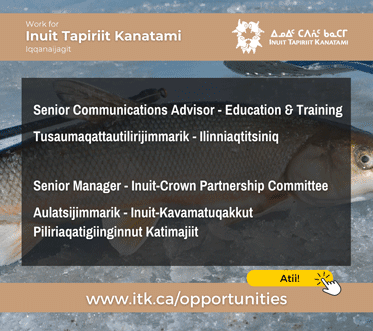Urban Inuit seek voice at Ottawa gathering
“I think it’s been an urgent situation for a long time”
Canada’s growing population of urban Inuit, tired of watching governments and land claims organizations ignore them, took a big step this week towards achieving a measure of justice and fairness.
Inuit from seven Canadian cities met at an Ottawa hotel on Wednesday and Thursday for a conference called “National Urban Inuit — One Voice,” organized by Tungasuvvingat Inuit and sponsored by the federal government’s Inuit Relations Secretariat.
“I think it’s been an urgent situation for a long time,” said the meeting’s facilitator, Mary Simon.
It’s the first such nation-wide gathering ever held by urban Inuit. Their aim was to talk about how to draw attention to their needs, how to get more recognition from the federal government, and how to gain better access to federal aboriginal funding programs.
Simon, Canada’s former circumpolar ambassador and ambassador to Denmark, serves on the board that runs Tungasuvvingat Inuit, a non-profit agency in Ottawa that has offered numerous social programs to Ottawa’s Inuit community since 1987.
She said her work on TI’s board opened her eyes to the serious problems faced by the many Inuit who move south and then disappear into poverty and homelessness.
“Through being on the board you get some awareness of things that are going on, such as homelessness, which is pretty bad, and Inuit who can’t get jobs because they’re not trained. There’s a lot more Inuit now living in this situation,” Simon said.
Ottawa-Gatineau is the only urban area with a social service agency that’s designed for Inuit. In other cities, Inuit have to deal with services and agencies that were originally designed for First Nations people.
Numbers from Statistics Canada’s 2001 census show that at least 5,000 Inuit — about 10 per cent of Canada’s Inuit population — now live outside the Arctic.
Census takers counted 3,145 scattered throughout British Columbia, Alberta, Saskatchewan, Manitoba, New Brunswick, Nova Scotia and Prince Edward Island, and 1,380 living in Ontario.
The largest population counts were in Ottawa-Gatineau (910), Yellowknife (660), Edmonton (465), Montreal (435), Toronto (355), Vancouver (260), and St. John’s (210).
But Simon, along with many other southern Inuit, says those counts are too low, and that Statistics Canada census-takers need to find better ways of counting Inuit who live in southern Canada.
For example, Statistics Canada counted 435 Inuit living in Montreal. But the former Association of Montreal Inuit has estimated that more than 900 actually live there.
She says that’s a big issue, because without hard, accurate population numbers, it will be difficult to convince federal government officials, especially those in charge of the National Urban Aboriginal Strategy, to spend more money on urban Inuit programs.
She said funding is available for urban aboriginal people, but nearly all of it goes to urban First Nations people.
To find a way of fixing that, organizers invited a representative from Statistics Canada to attend the meeting, along with Robert M. Bone, a well-known geography professor at the University of Saskatchewan. Bone talked about census undercounting of Inuit living in urban areas.
Simon said Inuit move south for a variety of reasons: to start a new job, to go to school, to get health care, or for family or personal reasons. And they come from one end of the Arctic to the other: Labrador, Nunavik, Nunavut, and Nunakput.
When they get there, they find themselves in a strange world, and are often surprised to discover that the rights and benefits they’re use to receiving within their land claim settlement areas aren’t available in the South.
For example, students may head south for post-secondary education, study for two years or so, take a year off to work, then try to go back to school to finish their diploma or degree.
But when they do that, they find that they no longer qualify for student financial assistance from their home territory.
Others run into big problems getting health care, such as Palluq Manning of Cape Dorset, a severely ill patient who discovered last summer that the Government of Nunavut does not consider him to be a Nunavut resident anymore.
And unlike most First Nations people, Inuit in the South have difficulty proving they’re eligible to have certain medical costs covered by the Non-Insured Health Benefits program.
To deal with those kinds of problems, meeting participants talked about “jurisdiction,” the question of who is responsible for doing what, a question that involves provincial and territorial governments, the federal government, Inuit land claim organizations, and groups like ITK and TI.
Above all, Simon said, urban Inuit need to see where they fit into the partnership accord signed this past May by Jose Kusugak, president of Inuit Tapiriit Kanatami, and Andy Scott, minister of Indian and northern affairs.
“For years the feds were referring all Inuit issues to the provinces and territories, but now ITK has been working with the other ministers to get a more focused Inuit agenda,” Simon said.





(0) Comments